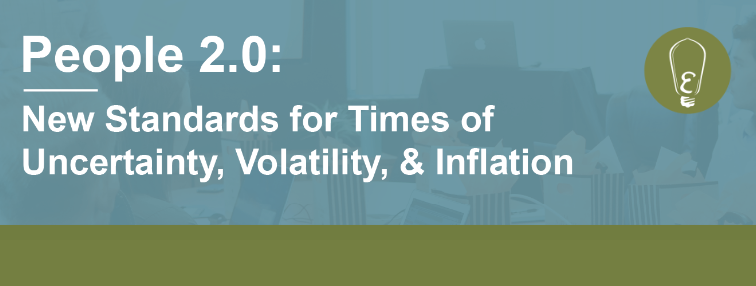 One of the great benefits of working with Edison Partners is the Edison Edge platform, which includes centers of excellence, programs and content that help portfolio companies navigate, accelerate and scale growth. With Edison Edge, Edison Partners goes beyond investing to providing the guidance that portfolio companies need to succeed. One aspect of the Edison Edge platform is the peer engagement programs produced annually in which executive teams and board members participate in functional and industry roundtables to share ideas and insights. Recently as part of Edison Partners’ Edge Platform event, “People 2.0 — New Standards for Times of Uncertainty, Volatility, and Inflation,” we broke out into functional teams (HR, go-to-market, finance, product, tech, etc.) to discuss people-related issues germane to our specific functional areas. Portfolio leaders present represented both pure software companies and software-enabled services companies. Our product and tech leaders (chief product officers, chief technology officers, VPs of product, engineering, etc.) discussed three topics: culture, recruiting, and remote work.
One of the great benefits of working with Edison Partners is the Edison Edge platform, which includes centers of excellence, programs and content that help portfolio companies navigate, accelerate and scale growth. With Edison Edge, Edison Partners goes beyond investing to providing the guidance that portfolio companies need to succeed. One aspect of the Edison Edge platform is the peer engagement programs produced annually in which executive teams and board members participate in functional and industry roundtables to share ideas and insights. Recently as part of Edison Partners’ Edge Platform event, “People 2.0 — New Standards for Times of Uncertainty, Volatility, and Inflation,” we broke out into functional teams (HR, go-to-market, finance, product, tech, etc.) to discuss people-related issues germane to our specific functional areas. Portfolio leaders present represented both pure software companies and software-enabled services companies. Our product and tech leaders (chief product officers, chief technology officers, VPs of product, engineering, etc.) discussed three topics: culture, recruiting, and remote work.

Culture is undeniably the most important people topic for any organization, particularly a product and technology organization because we tend to be mission-driven versus coin-operated. That said, what does good culture look like and how do we “get good”? We asked our product and technology leaders to familiarize themselves with both the Westrum cultural framework and Google’s Project Aristotle to inform our discussion (links to both included below). The Westrum framework characterizes generative, bureaucratic, and pathological cultures. The research shared by Nicole Forsgren in her book “Accelerate” proved a strong positive correlation between a generative culture and a high-performing software organization. We discussed the various attributes of a generative culture including performance-oriented, highly cooperative, messengers trained, risks shared, bridging encouraged, failure leads to inquiry, and novelty implemented. In the end we agreed that these attributes were at least a subset of “what good culture looks like” and worth pursuing. At some point I would like to survey the Edison portfolio to determine how many of our companies have generative versus bureaucratic versus pathological cultures — I’d like to think they all have some form of generative!
Google undertook Project Aristotle to ascertain attributes associated with highly productive teams across product, technology, and sales. They identified dependability, structure/clarity, meaning, impact, and psychological safety — with psychological safety topping the list as the most critical attribute of highly productive teams. Additionally, colocation, consensus, extroversion, individual performance, workload, seniority, team size, and tenure were identified as non-critical attributes of highly productive teams. Our group definitely got the importance of psychological safety and related it to the idea of a “blameless retro” in Agile parlance. If folks don’t feel comfortable speaking their minds, the team will never surface all of the possible good and bad ideas! One of our more vocal participants questioned whether or not Google teams are a fair proxy for non-Google teams. This is an interesting point in that Google is a giant public company, not an early, mid- or later-stage growth company. In my view their findings are totally consistent with what I have seen at both small startups and large, public companies. Look at AWS, they’re a mega cap but the one- and two-pizza team concepts are still applicable to smaller organizations. Additionally, psychological safety isn’t a function of team or org size. So, I’d strongly suggest looking carefully at the Google Aristotle results and helping your teams and your company establish a culture of psychological safety!


Recruiting — Unfortunately we didn’t get enough time to dig in deeply on the recruiting process as a team. That said, we did discuss the importance of an effective onboarding program. One of our team members asked new members of the team to create a personal “user guide” so that others could get a good sense for how to interact with them. Additionally, everyone agreed that onboarding and getting new team members up to speed is more difficult in a primarily remote or exclusively remote work environment. That’s not to say it’s impossible, it’s just to say it requires more investment in documentation and asynchronous mechanisms. Topics that I look forward to discussing with this group in a future session include sourcing, screening/testing, and interviewing practices. Generally speaking, our best source of new hires is existing employees so how do we encourage them to “tell a friend” beyond some form of referral bonus? At the risk of sounding like a one note piano player, a great culture incorporating psychological safety and some of Westrum’s generative culture attributes is a powerful recruiting (and retention) tool. Folks are more compelled to recruit a friend into a culture that they believe in. Because the interviewing process is a big investment of time and valuable team members identifying qualified candidates ahead of the interviewing process through screening is critically important. Being explicit about must haves versus nice to haves in the job description as well as leveraging some objective testing mechanism can help to assure well qualified candidates are the only candidates the team interviews. Edison has taken a hard look at the recruiting (source-screen-onboard) space. There are several interesting companies offering software and software enabled services in the space.

Remote work versus exclusively remote work/work from home has always been a part of most product and technology organizations. In certain domains (e.g., security and data science) hiring folks in other parts of the country or the world is a practical necessity. There just aren’t enough folks in those disciplines to hire into a local office, no matter where it is. Additionally, most technology teams have leveraged multi-shoring development via third parties or captive centers around the world. So, managing a remote workforce wasn’t new to us as leaders, but managing an exclusively remote workforce (due to Covid) was! Here were some of the take-aways from our remote work session:
・Broad agreement that, like it or not, we are living in a post-COVID world where you will either support remote/distributed working models or lose out on recruiting certain candidates who have become accustomed to the work from home/distributed model.
・Pre-/post-COVID workstyles didn't have a significant impact on aggregate productivity because some folks flourished, and others didn't — net/net about the same productivity.
・A common opinion in the room was that candidates recruited during the pandemic who did not experience in-person interviewing and onboarding were less “committed to the cause” and more opportunistic, and possibly more likely to quit in six to 12 months.
・Distributed/remote work must include budgeting for some in-person meetings for both individual teams and the collective organization to build cohesion.
There was so much to cover and so little time! But I left the group with these takeaways:






